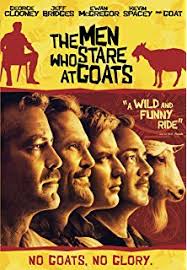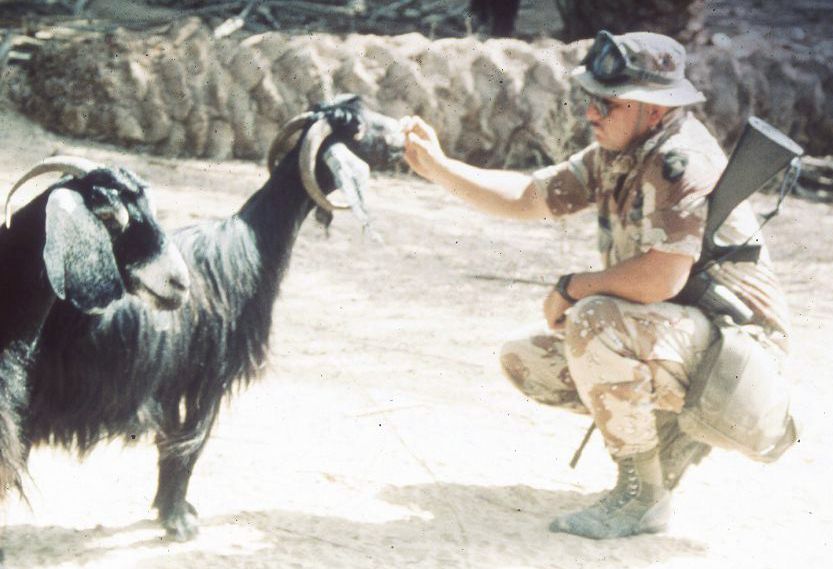 No Goats Were Harmed In The Writing Of This Review
No Goats Were Harmed In The Writing Of This Review
By Paul H. Smith
By now you have probably noticed the excitement about the new movie The Men Who Stare at Goats among people interested in remote viewing. They may love it, they may hate it, but they aren’t ignoring it, because it is now only one of two films in which remote viewing plays an important role. The first was 2004’s Suspect Zero, a dark, violent thriller of a movie that featured Sir Ben Kingsley as a remote-viewing serial killer of serial killers. In mood, Goats is almost the polar opposite of Zero. Goats is humorous, often light-hearted, though also at times cynical and satirical — and, there’s still a little violence (some of it involving goats). But in general, the two films couldn’t be much more different.
What is the movie about? The Men Who Stare at Goats is loosely based on a book of the same name by Jon Ronson. Both book and movie focus on a now-defunct military program that explored so-called ‘psychic powers’ — a form of a scientifically-based extra-sensory perception called “remote viewing.” If you are new to this website, click here to learn what remote viewing is, or click here to read about the origins of remote viewing. In the book and movie, the remote viewing program is tied to other, darker things. This tie-in with darker things makes the story more exciting. But remote viewing had little or no connection to those things in reality. You can find out more about that by reading my review of The Men Who Stare At Goats, the book.

Remote Viewing and Goats. The Men Who Stare at Goats doesn’t have quite as much about remote viewing in it as does Suspect Zero (after all, it has to include peaceful warrior skills, gentle martial arts, and let’s not forget the goat-staring). But, like Zero, the Goats movie gets mixed reviews for how it portrays RV. One scene has three of the characters sitting in chairs facing a huge bank of what appear to be library card file drawers (you know — the kind they used to use before computers took over the job). The erstwhile viewers are given a drawer number, and are supposed to guess what is in the drawer. “A pencil” the first viewer guesses. “A tin cup,” the Kevin Spacey character declares, in a hilarious high falsetto that mimics a spirit guide with an Indian accent. “A man in a chair,” decides George Clooney. The image that is pulled from an envelope tucked away in the drawer turns out to be Abraham Lincoln sitting on his throne in the Lincoln Memorial. Well, not exactly the way remote viewing works — but at least one of them got a hit. Another instance of remote viewing, however, goes awry. The mission is to locate the whereabouts of Manuel Noriega during the Panama invasion. “Ask Angela Lansbury” says a viewer while in a trance. And, of course, Angela Lansbury knows nothing about Noriega. Again, not exactly remote viewing — and it has negative consequences for the remote viewing program being skewered in Goats.
Who is in the film? As far as the most important characters, George Clooney plays the main character, “Lyn Cassidy.” The character is clearly a combination of numerous people with a connection to the remote viewing program. Jeff Bridges is “Bill Django,” a combat officer who sees the light and tries to introduce enlightened (read: new-agey and counterculture) ways into the US Army, hollowed out by its Vietnam experience. Ewan McGregor plays “Bob Wilton,” a rootless journalist trying to find a story that will give his life meaning. Kevin Spacey is the devious “Larry Hooper,” whose actions bring about the demise of the paranormal program. And finally, the mercurial “General Hopgood,” who works to aid and abet Django’s reforms, is played by Stephen Lang. (To see the various people I have thus far identified as character inspirations, click here.)
What happens? After many flashbacks to the original secret military paranormal unit called the “New Earth Army” — including a scene where Clooney, using mental powers, stares a rather startled-looking goat to death — Clooney and McGregor end up in Iraq trying to track down the latest incarnation of the New Earth Army. There are many adventures, most amusing, some sad, some depressing — and some amusing, sad and depressing all at the same time. Like a humorous send-up of Apocalypse Now set in the Iraqi desert, in the end they find the colonel they are looking for, now a broken-down drunk who nonetheless still has enough spunk in him to help McGregor and Clooney liberate a herd of hapless goats destined to be stared to death, plus a gaggle of Iraqi prisoners who had been tortured by having been made to listen to the Barney song over and over 24/7. (Note: it’s nice to see the goats scamper free, but one wonders if some of the escaping orange-jump-suited Iraqis may not spend the next few days emplacing some IEDs to blow up our heroes on their return journey.)
Is it at all accurate as a portrayal of real events? No. There are bits of pieces of many real events sprinkled throughout, but almost without exception they have been pureed in a screenwriter’s blender to the point where actual historical representations and linkages have been lost. This, actually, is a saving grace. The book was dangerous because it pretended to be a generally accurate account, while working insidiously to undermine the credibility of Star Gate and the other programs the book pretended to “document.” With the film, there is no pretense of being the literal truth. If you have seen the movie, you will likely agree that it is amusing, humorous, and mostly inaccurate — intentionally so. If you have not seen the movie, I recommend it — you will find it amusing, humorous, and intentionally inaccurate. But the inaccuracy doesn’t hurt — as long as you don’t take it seriously, it contributes to the amusement and the humor and, surprisingly, leaves you wondering if there might not have been something to the military’s brush with ESP after all.